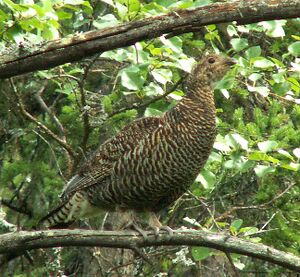Grouse
-
Red grouse
-
Black grouse
-
Willow grouse
The Red Grouse (Lagopus lagopus scotica) is a medium sized bird of the grouse family which is found in heather moorland in Great Britain and Ireland. It is usually classified as a subspecies of the Willow Grouse (but is sometimes considered to be a separate species Lagopus scoticus. It is also known as the moorfowl or moorbird.
The Red Grouse is endemic to the British Isles; it has developed in isolation from other subspecies of the Willow Grouse which are widespread in northern parts of Eurasia and North America.
It is found across most parts of Scotland, including Orkney, Shetland and most of the Outer Hebrides. They are only absent from urban areas, such as the central belt, the flatter areas of the north-east and around Fife.
In Wales there are strong populations in places but their range has retracted. They are now largely absent from the far south, their main strongholds being Snowdonia, the Brecon Beacons and the Cambrian Mountains. There are reports of Welsh birds crossing the Bristol Channel to Exmoor.
In England it is mainly found in the north - places such as the Lake District, Northumberland, County Durham, much of Yorkshire, the Pennines and the Peak District, as far south as the Staffordshire Moorlands. There is an isolated introduced population on Dartmoor, and overspill Welsh birds visit the Shropshire Hills such as Long Mynd, where they breed. The Exmoor population would now appear to be extinct, with the last birds sighted as recently as 2005. An introduced population in Suffolk died out by the early 20th century, though a population on Cannock Chase in Staffordshire lasted longer.
In Ireland it is found locally in most parts of the country.
Its typical habitat is upland heather moors away from trees. It can also be found in some low-lying bogs and birds may visit farmland during hard weather.
The British population is estimated at about 250,000 pairs with around 1-5,000 pairs in Ireland. Numbers have declined in recent years and birds are now absent in areas where they were once common. Reasons for the decline include loss of heather due to overgrazing, creation of new conifer plantations and a decline in the number of upland gamekeepers. Some predators such as the Hen Harrier feed on grouse and there is ongoing controversy as to what effect these have on grouse numbers.
The Glorious Twelfth
The Red Grouse is considered a game bird and is shot in large numbers during the shooting season which traditionally starts on the 12th of August, known as the Glorious Twelfth.
Shooting can take the form of 'walked up' (where shooters walk across the moor to flush grouse and take a shot) or 'driven' (where grouse are driven, often in large numbers. by 'beaters' towards the guns who are hiding behind a line of 'butts'). Many moors are managed to increase the density of grouse. Areas of heather are subjected to controlled burning; this allows fresh young shoots to regenerate, which are favoured by the grouse. Extensive predator control is a feature of grouse moor management: foxes, stoats and crows are usually heavily controlled on grouse moors.
Willow grouse
The Willow Grouse (Lagopus lagopus) or Willow Ptarmigan is a bird of the grouse subfamily. It is a sedentary species, breeding in birch and other forests and moorlands in the tundra of Scotland, Scandinavia, Siberia, and of Alaska and northern Canada. It is the state bird of Alaska.
Black grouse
The Black Grouse or Blackgame (Tetrao tetrix) is a large bird in the grouse family. It is a sedentary species, breeding across northern Eurasia in moorland and bog areas near to woodland, mostly boreal. The Black Grouse is closely related to the Caucasian Black Grouse.
Black Grouse is a large bird with males being 24–27 centimetres (9.4–11 in) long and weighing 1,000–1,450 grams (2.2–3.2 lb) and females 21–24 centimetres (8.3–9.4 in) and weighing 750–1,110 grams (1.7–2.4 lb)
This species is declining in western Europe due to loss of habitat, disturbance, predation by foxes, crows, etc., and small populations gradually dying out.
They have declined in the UK (especially England), having disappeared from many of their former haunts. They are now extirpated in Lancashire, Derbyshire, Exmoor, East Yorkshire, New Forest, Nottinghamshire, Worcestershire, Quantock Hills, Cornwall, Dartmoor, Kent, Wiltshire and Surrey.
A program to re-introduce Black Grouse into the wild started in 2003 in the Upper Derwent Valley area of the Peak District in England. 30 grouse were released in October 2003, followed by 10 male grouse in December 2004 and a further 10 male and 10 female in April 2005. The programme is being run jointly by the National Trust, Severn Trent Water and Peak District National Park.
Conservation groups helping to revive the Black Grouse include the RSPB and the Game & Wildlife Conservation Trust.
Seasonal Information: Grouse
This information is specifically for countries in the northern temperate zone of the Northern Hemisphere; particularly the United Kingdom, however it should be applicable for northern USA, northern Europe, Canada, Russia, etc.
Grouse is at its best and in season during the following months: September, October, November & December.
Useful links
Find recipes that contain 'Grouse'
#grouse #agrousecookingtimecalculator #wheretobuygrouse #poultry


